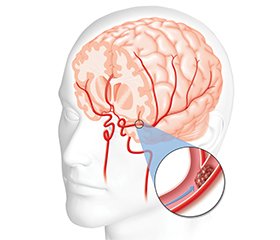Резюме
У статті висвітлюються основні патофізіологічні механізми розвитку серцево-судинних порушень при гострому мозковому інсульті, котрі включають в себе як дисфункцію гіпоталамо-гіпофізарно-наднирникової осі, порушення вегетативної регуляції серцевої діяльності, імунну відповідь, так і погіршення в роботі серцево-судинної системи за уже наявних структурних, органічних уражень серця і судин, що, у свою чергу, може поглиблювати розвиток церебрального ураження. Наведено літературні дані про клініко-електрофізіологічні, біохімічні зміни в серцево-судинній системі при інсульті, зокрема залежно від ділянки ушкодження речовини головного мозку. Акцентується увага на можливих гемодинамічних порушеннях, електрокардіографічних змінах у роботі серця, підвищенні рівнів серцевих тропонінів, мозкового натрійуретичного пептиду, С-реактивного білка. Ускладнення, які виникають у цієї категорії пацієнтів, мають велике клінічне значення й суттєво впливають на перебіг хвороби та подальший прогноз, що вимагає пильної уваги не тільки неврологів, але й лікарів суміжних спеціальностей.
The article highlights the main pathophysiological mechanisms of cardiovascular disorders in acute cerebral stroke, which include dysfunction of the hypothalamic-pituitary-adrenal axis, disorders of autonomic regulation of cardiac activity, immune response, and deterioration in the cardiovascular system in case of existing structural, organic lesions of the heart and blood vessels, which in turn can exacerbate the development of cerebral damage. Literature data on clinical, electrophysiological, and biochemical changes in the cardiovascular system in stroke are presented, in particular, depending on the area of brain damage. Attention is focused on possible hemodynamic disturbances, electrocardiographic changes in the heart, increased levels of cardiac troponins, brain natriuretic peptide, and C-reactive protein. Complications that arise in this category of patients are of great clinical importance and significantly affect the course of the disease and further prognosis, which requires close attention not only from neurologists but also from doctors of related specialties.
Список литературы
1. Негрич Т.І., Боженко Н.Л., Матвієнко Ю.О. Ішемічний інсульт: вторинна стаціонарна допомога. Навчальний посібник (для студ. мед. факультету вищих навчальних закладів другого (магістерського) рівня вищої освіти, лікарів-інтернів неврологів, неврологів, лікарів сімейної медицини). Львів, 2019. 160 с.
2. Building a stroke agenda for Ukraine: situation analysis 2021. Copenhagen: WHO Regional Office for Europe. WHO/EURO:2022-5641-45406-64977.
3. Valery L Feigin, Mayowa O Owolabi. Pragmatic solutions to reduce the global burden of stroke: a World Stroke Organization — Lancet Neurology Commission. Lancet Neurol. 2023 October 9;22:1160-1206.
4. Stephen JX Murphy, David J Werring. Stroke: causes and clinical features. Medicine. 2020 Sep;48(9): 561-566. doi.org/10.1016/j.mpmed.2020.06.002.
5. Sergiy Stadnik. Cerebrocardial syndrome in ischemic stroke. Proceedings of the Shevchenko Scientific Society. Medical Sciences Vol. 2022. 66 No. 1. doi: 10.25040/ntsh2022.01.09.
6. Mihalovic M, Tousek P. Myocardial Injury after Stroke. J. Clin. Med. 2022;11:2. doi: 10.3390%2Fjcm11010002.
7. Jungehülsing G, Endres M. Komplikationen und Folgeerkrankungen nach Schlaganfall., ed. 1. Auflage. Stuttgart: Thieme. 2015; 216 s. doi: 10.1055/b-003-124634.
8. Denise Battaglini, Chiara Robba, Adriana Lopes da Silva et al. Brain-heart interaction after acute ischemic stroke. Critical Care. 2020;24:163. https://doi.org/10.1186/s13054-020-02885-8.
9. Gunnoo T, Hasan N, Khan MS et al. Quantifying the risk of heart disease following acute ischaemic stroke: a meta-analysis of over 50 000 participants. BMJ Open. 2016;6:e009535. Doi: 10.1136/bmjopen-2015-009535.
10. Calandra-Buonaura G, Dampney RAL, Cortelli P. 2016 Brain — heart interactions. Philosophical Transactions of the Royal Society A: Mathematical, Physical and Engineering Sciences. 2016;374(2067). http://dx.doi.org/10.1098/rsta.2015.0181.
11. Amanda J, Paul G, Susan DS. Cortisol levels and the seve-rity and outcomes of acute stroke: a systematic review. J Neurol. 2014 March;261(3):533-545. Doi: 10.1007/s00415-013-7231-5.
12. Hrishi AP, Lionel KR, Prathapadas U. Head Rules Over the Heart: Cardiac Manifestations of Cerebral Disorders. Indian J Crit Care Med. 2019;23(7):329-335. doi: 10.5005/jp-journals-10071-23208.
13. Ardell JL, Andresen MC, Armour JA et al. Translational neurocardiology: preclinical models and cardioneural integrative aspects. J Physiol. 2016 Jul 15;594(14):3877-3909. doi: 10.1113/JP271869.
14. Britta W, Matthias K, Catherine S. Structural imaging biomarkers of sudden unexpected death in epilepsy. Brain. 2015 Oct;138(10):2907-2919. doi: 10.1093/brain/awv233.
15. Gopinath R, Ayya S. Neurogenic stress cardiomyopathy: what do we need to know. Ann Card Anaesth. 2018;21:228. doi: 10.4103/aca.ACA_176_17.
16. Campbell BCV, De Silva DA, Macleod MR et al. Ischaemic stroke. Nat Rev Dis Prim. 2019;5:1-22. doi: 10.1038/s41572-018-0051-2.
17. Friberg L, Rosenqvist M, Lindgren A et al. High Prevalence of Atrial Fibrillation Among Patients With Ischemic Stroke. Stroke. 2014;45:2599-2605. doi: 10.1161/STROKEAHA.114.006070.
18. Mochmann H-C, Scheitz J, Petzold GC et al. Coronary Angiographic Findings in Acute Ischemic Stroke Patients With Elevated Cardiac Troponin. Circulation. 2016;133:1264-1271. doi: 10.1161/CIRCULATIONAHA.115.018547.
19. He L, Wang J, Dong W. The clinical prognostic significance of hs-cTnT elevation in patients with acute ischemic stroke. BMC Neurol. 2018;18(1):118. doi: 10.1186/s12883-018-1121-5.
20. Bunevicius A, Kazlauskas H, Raskauskiene N et al. Role of N-Terminal Pro-B-Type Natriuretic Peptide, High-Sensitivity C-Reactive Protein, and Inteleukin-6 in Predicting a Poor Outcome after a Stroke. Neuroimmunomodulation. 2015;22:365-372. doi: 10.1159/000381218.
21. Curry SJ, Krist AH, Owens DK et al. Risk assessment for cardiovascular disease with nontraditional risk factors: US preventive services task force recommendation statement. JAMA. 2018;320:272-280. doi: 10.1001/jama.2018.8359.
22. Abdi S, Oveis-Gharan S et al. Elevated troponin T after acute ischemic stroke: Association with severity and location of infarctin. Iran J Neurol. 2015;14(1):35-40.
23. Samary CS, Pelosi P, et al. Immunomodulation after ischemic stroke: potential mechanisms and implications for therapy. Crit Care. 2016;20:391. doi: 10.1186/s13054-017-1834-7.
24. Bhatia R, Sharma G, Patel C et al. Coronary artery disease in patients with ischemic stroke and TIA. J Stroke Cerebrovasc Dis. 2019;28(12):104400. https://doi.org/10.1016/j.jstrokecerebrovasdis.2019.104400.
25. Wachter R, Gröschel K, Gelbrich G et al. Holter-electrocardiogram-monitoring in patients with acute ischaemic stroke (FindAFRANDOMISED): an open-label randomised controlled trial. Lancet Neurol. 2017;16:282-290. doi: 10.1016/S1474-4422(17)30002-9.
26. Jung S, Meinel T, Mattle H und andere. Stroke Richtlinien des Berner Stroke Netzwerks. Stroke-Team Bern. Version 2024.
27. Aleksey M. Chaulin. Elevation Mechanisms and Diagnostic Consideration of Cardiac Troponins under Conditions Not Associated with Myocardial Infarction. Part 2. Life. 2021;11(11):1175. https://doi.org/10.3390/life11111175.
28. Cui Y, Ren H, Lee C et al. Characteristics of elevated cardiac troponin I in patients with acute ischemic stroke. J Geriatr Cardiol. 2017 Jun;14(6):401-406. doi: 10.11909/j.issn.1671-5411.2017.06.001.

